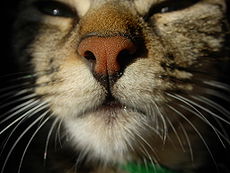
Back Nasenspiegel ALS رطبة الأنف Arabic Rinarij BS Rinari Catalan Nasenspiegel German Rinario Spanish Rhinarium Basque چرم بینی Persian Kirsu Finnish Rhinarium French


and conspicuous crenellations
The rhinarium (Neo-Latin, "belonging to the nose"; pl.: rhinaria)[1] is the furless skin surface surrounding the external openings of the nostrils in many mammals. Commonly it is referred to as the tip of the snout, and breeders of cats and dogs sometimes use the term nose leather. Informally, it may be called a "truffle", "wet snout," or "wet nose” because its surface is moist in some species: for example, healthy dogs and cats.[2]
In many species, the rhinarium has a mid-line groove (cleft) – the philtrum – and a wrinkled (crenellated) surface.[3] The rhinarium is a separate sense organ: it is a touch-based chemosensory organ that connects with a well-developed vomeronasal organ (VNO). The rhinarium is used to touch a scent-marked object containing pheromones (usually large, non-volatile molecules), and transfer these pheromone molecules down the philtrum to the VNO via the nasopalatine ducts that travel through the incisive foramen of the hard palate.[4] It also acts as a wind-direction detector: cold receptors in the skin of the rhinarium detect the orientation where evaporative cooling is highest, as determined by the wind direction.
The study of the rhinarium's structure and associated functions has proven of considerable importance in the fields of mammalian evolution and taxonomy.[5] For example, primates are phylogenetically divided into those, such as lemurs, with the primitive rhinarium (Strepsirrhini) and the dry-nosed primates (Haplorhini, including apes and thus humans).
In an analogous way – entirely unrelated to vertebrate morphology – the term rhinarium is sometimes applied to chemosensory structures in invertebrates. For example, microscopic sensilla in the form of flattened sense organs on the antennae of aphids are referred to as rhinaria.[6]
- ^ "rhinarium, -arium". Webster's Third New International Dictionary (Unabridged ed.). Encyclopædia Britannica, Inc. 1986.
- ^ Ankel-Simons, Friderun (2010). Primate anatomy: an introduction. San Diego: Academic Press. p. 392. ISBN 9780080469119.
In most mammals we find a moist and shiny glandular area around the nostrils....
- ^ Lund University Faculty of Science Department of Biology Mammalian Rhinarium Group [1]
- ^ Ankel-Simons 2010, pp. 392–514.
- ^ Basbaum, Allan I. Kaneko, Akimichi, Shepherd, Gordon G. Westheimer, Gerald (editors). The Senses: A Comprehensive Reference. Academic press 2007. ISBN 978-0126394825
- ^ Du Yongjun Yan Fushun Tang Jue. "Structure and Function of Olfactory Sensilla on the Antennae of Soybean Aphids, Aphis glycines". ACTA Entomologica Sinica 1995, Vol. 38 Issue (1): 1–7 [2]
© MMXXIII Rich X Search. We shall prevail. All rights reserved. Rich X Search